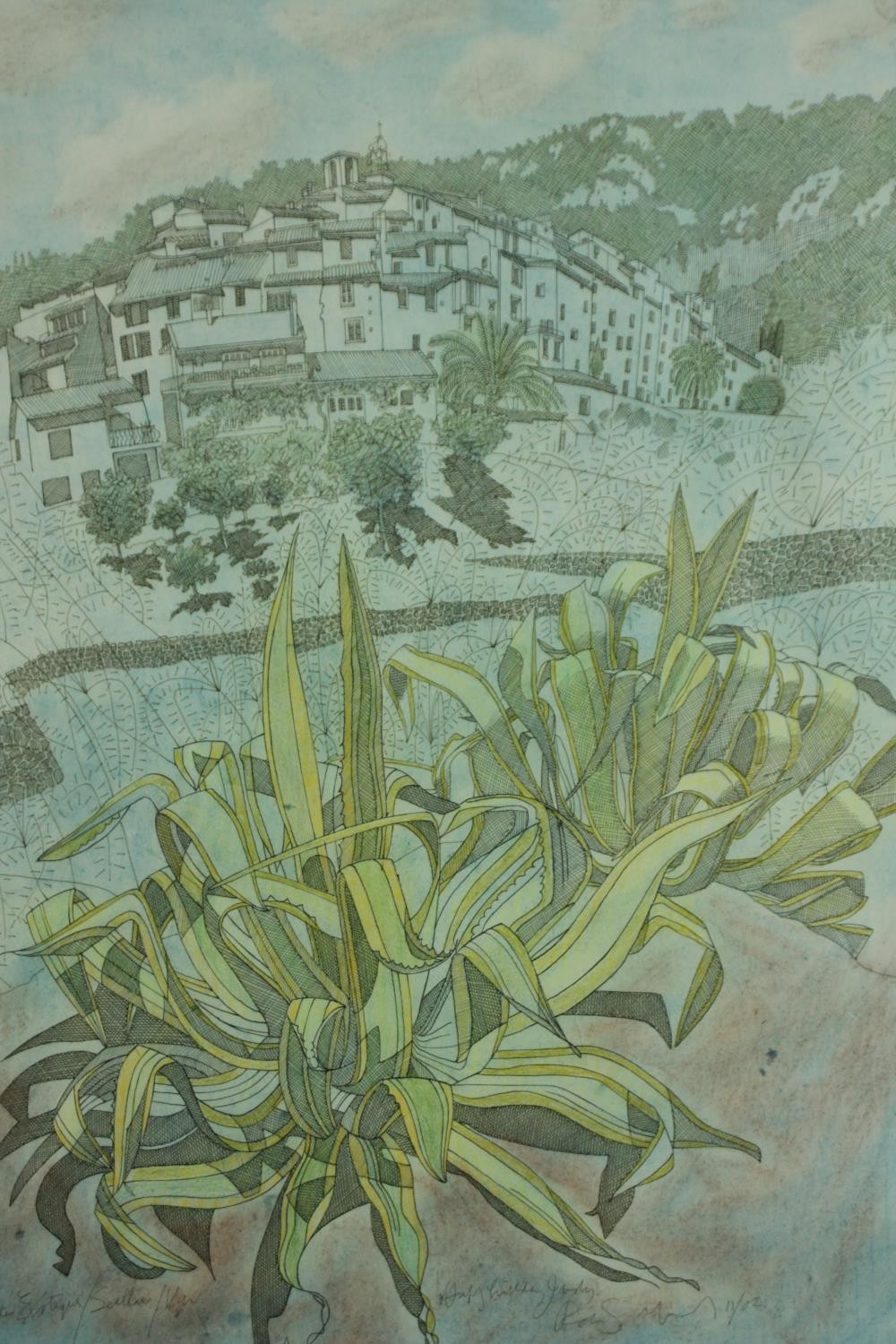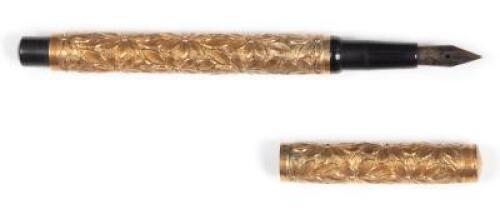Lot details China, 6th century. Depicting a standing Buddha, dressed in loose robes draped over both shoulders and elegantly falling in stepped folds flaring at the hems in stylized pleats, the robe open at the chest to reveal the tied underskirt. The overall simple and naturalistic style clearly dates it to the later sixth century. Clinging tightly, the diaphanous drapery reveals the elegant body’s form, characteristically indicated by incised lines and relief ridges. Provenance: Old Italian private collection, acquired 1971 from Wing Tat Hong Gallery, Hong Kong. Collection of Leonardo Vigorelli, Bergamo, acquired from the above. Leonardo Vigorelli is a retired Italian art dealer and noted collector, specializing in African and ancient Hindu-Buddhist art. After studying anthropology and decades of travel as well as extensive field research in India, the Himalayan region, Southeast Asia, and Africa, he founded the Dalton Somaré art gallery in Milan, Italy, which today is being run by his two sons. Condition: Good condition, commensurate with age. Extensive wear, signs of weathering and erosion, encrustations, losses, nicks and surface scratches, minor cracks. Remnants of ancient pigment. Displaying supremely. Dimensions: Height 92 cm (excl. base) and 101.5 cm (incl. base) Mounted to a modern metal base. (2) Expert’s note: This magnificent sculpture embodies a profound spirituality achieved through the remarkable plasticity of drapery and form. The figure represents a standing Buddha and the monk’s robes, which he wears, are arrayed to cover both shoulders. The size, sensitivity of carving, crisp treatment of the gracefully draped folds, both those falling in parallel curved lines down the front of the subtly indicated body and those of the hem, closely relate this figure to other imposing white marble statues of a similar date. Only occasionally encountered among Chinese Buddhist sculptures, white marble first rose to popularity during the Northern Qi period, when sculptors occasionally carved Buddhist images in beautiful white marble from Dingzhou, in southwest Hebei province. Although a quarry site can never be taken as the probable site at which a particular image was sculpted, the use of white marble nevertheless suggests that this extraordinary sculpture might have been carved in the vicinity of Dingzhou, likely in Hebei or Shanxi province. Faint traces of polychromy, evident on the shoulders, suggest that the sculpture was once entirely painted, as were virtually all early Indian and Chinese Buddhist sculptures in wood and stone. The brilliant pigments of the sculptures and wall paintings at Dunhuang, in Gansu province, suggest that the original colors of this Buddha would have been stunning. If the missing right arm was raised in the abhayamudra, then the left might have shown a variation of the varadamudra, the gift-giving gesture, also associated with preaching. Moreover, if the right arm displayed the abhayamudra then the present sculpture likely represented either the Historical Buddha Shakyamuni or Amitabha, the Buddha of Boundless Light, in a preaching mode. Because the sculpture lacks an identifying inscription, not to mention its right arm and any distinguishing iconographic attributes, the exact identity of this Buddha likely will remain an enigma. Literature comparison: Compare a related figure of Amitabha Buddha in the Royal Ontario Museum, illustrated in Homage to Heaven, Homage to Earth, 1992, p. 163, pl. 92. Compare a related figure illustrated in Chinese Marble Sculptures of the Transition Period, B.M.F.E.A., no. 12, Stockholm, 1940, pl. II (b). Compare a related sculpture in the Eskenazi exhibition Sculpture and ornament in early Chinese art, London, 11 June to 13 July 1996, no. 31. Auction result comparison: Type: Closely related Auction: Christie’s London, 12 May 2004, lot 203 Price: EUR 101,575 or approx. EUR 143,500 adjusted for inflation at the time of writing Description: A Chinese stone torso of B
Lot details China, 6th century. Depicting a standing Buddha, dressed in loose robes draped over both shoulders and elegantly falling in stepped folds flaring at the hems in stylized pleats, the robe open at the chest to reveal the tied underskirt. The overall simple and naturalistic style clearly dates it to the later sixth century. Clinging tightly, the diaphanous drapery reveals the elegant body’s form, characteristically indicated by incised lines and relief ridges. Provenance: Old Italian private collection, acquired 1971 from Wing Tat Hong Gallery, Hong Kong. Collection of Leonardo Vigorelli, Bergamo, acquired from the above. Leonardo Vigorelli is a retired Italian art dealer and noted collector, specializing in African and ancient Hindu-Buddhist art. After studying anthropology and decades of travel as well as extensive field research in India, the Himalayan region, Southeast Asia, and Africa, he founded the Dalton Somaré art gallery in Milan, Italy, which today is being run by his two sons. Condition: Good condition, commensurate with age. Extensive wear, signs of weathering and erosion, encrustations, losses, nicks and surface scratches, minor cracks. Remnants of ancient pigment. Displaying supremely. Dimensions: Height 92 cm (excl. base) and 101.5 cm (incl. base) Mounted to a modern metal base. (2) Expert’s note: This magnificent sculpture embodies a profound spirituality achieved through the remarkable plasticity of drapery and form. The figure represents a standing Buddha and the monk’s robes, which he wears, are arrayed to cover both shoulders. The size, sensitivity of carving, crisp treatment of the gracefully draped folds, both those falling in parallel curved lines down the front of the subtly indicated body and those of the hem, closely relate this figure to other imposing white marble statues of a similar date. Only occasionally encountered among Chinese Buddhist sculptures, white marble first rose to popularity during the Northern Qi period, when sculptors occasionally carved Buddhist images in beautiful white marble from Dingzhou, in southwest Hebei province. Although a quarry site can never be taken as the probable site at which a particular image was sculpted, the use of white marble nevertheless suggests that this extraordinary sculpture might have been carved in the vicinity of Dingzhou, likely in Hebei or Shanxi province. Faint traces of polychromy, evident on the shoulders, suggest that the sculpture was once entirely painted, as were virtually all early Indian and Chinese Buddhist sculptures in wood and stone. The brilliant pigments of the sculptures and wall paintings at Dunhuang, in Gansu province, suggest that the original colors of this Buddha would have been stunning. If the missing right arm was raised in the abhayamudra, then the left might have shown a variation of the varadamudra, the gift-giving gesture, also associated with preaching. Moreover, if the right arm displayed the abhayamudra then the present sculpture likely represented either the Historical Buddha Shakyamuni or Amitabha, the Buddha of Boundless Light, in a preaching mode. Because the sculpture lacks an identifying inscription, not to mention its right arm and any distinguishing iconographic attributes, the exact identity of this Buddha likely will remain an enigma. Literature comparison: Compare a related figure of Amitabha Buddha in the Royal Ontario Museum, illustrated in Homage to Heaven, Homage to Earth, 1992, p. 163, pl. 92. Compare a related figure illustrated in Chinese Marble Sculptures of the Transition Period, B.M.F.E.A., no. 12, Stockholm, 1940, pl. II (b). Compare a related sculpture in the Eskenazi exhibition Sculpture and ornament in early Chinese art, London, 11 June to 13 July 1996, no. 31. Auction result comparison: Type: Closely related Auction: Christie’s London, 12 May 2004, lot 203 Price: EUR 101,575 or approx. EUR 143,500 adjusted for inflation at the time of writing Description: A Chinese stone torso of B

.jpg)
.jpg)






.jpg)




Try LotSearch and its premium features for 7 days - without any costs!
Be notified automatically about new items in upcoming auctions.
Create an alert